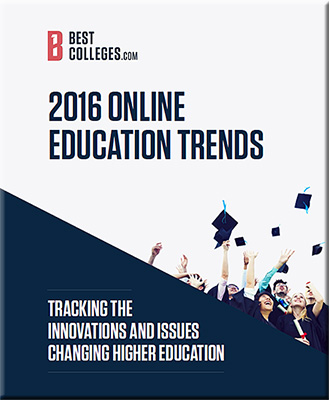2016 Online Education Trends — from bestcolleges.com
Tracking the innovations and issues changing higher education
Excerpt:
Key issues are identified in three categories:
- The state of online teaching and learning
- Technology and tomorrow’s learning environments
- The cost of online education
Through completely online virtual schools, hybrid or blended learning options, and some state-level requirements, K-12 students are entering college with online learning experience.
The results suggest that there are six new major types of students enrolling in college today. These types have multifaceted motivations and the need to consider more than just age or delivery platform when planning everything from curriculum and support services to marketing initiatives.
- Aspiring Academics: high-achieving, high-income recent high school graduates who want the traditional college experience and professional focus, which may include graduate school
- Coming of Age: unsure about career goals or major, but trust that college is the way forward
- Career Starters: interested in majors that lead to specific careers; focused on researching program costs and placement rates when making college decisions
- Career Accelerators: already working full-time and interested in advancing in their existing career field with part-time college options
- Industry Switchers: have work experience, but want to change career fields; focused on cost, online and hybrid options, job placement services
- Academic Wanderers: often returning to college after a break; unsure about career goals, but focused on finding low-cost higher education options to help them move forward
…
From the Who is teaching online? section:
Across higher education, online and on campus, the new normal is a reduction in full-time tenure-track faculty members and an increase in part-time or contract-based instructors in what are often referred to as contingent or adjunct positions.
…
According to the American Association of University Professors (AAUP), “more than 50% of all faculty hold part-time appointments” [9]. This doesn’t mean, however, that they are not working the equivalent of full-time hours or teaching a full-time course load. Almost 75% of faculty are considered “non-tenure track,” meaning that they may work part-time or full-time, but without the support and resources usually available to those in tenure-track positions [10].
Education consultant Peter Stokes recently called for a switch in language and approach. Online learning has become synonymous with “tuition streams” and “content development,” and perhaps a specific type of degree program. Stokes recommends replacing this term with digital strategy. This all-encompassing term more accurately describes not only delivery mode and administrative decisions, but also “pedagogy”, “market relevance” and the use of educational technology in on-campus programs as well [26]. This broader focus represents the reality of today’s higher education system, which increases student access to college while improving the overall learning experience.









